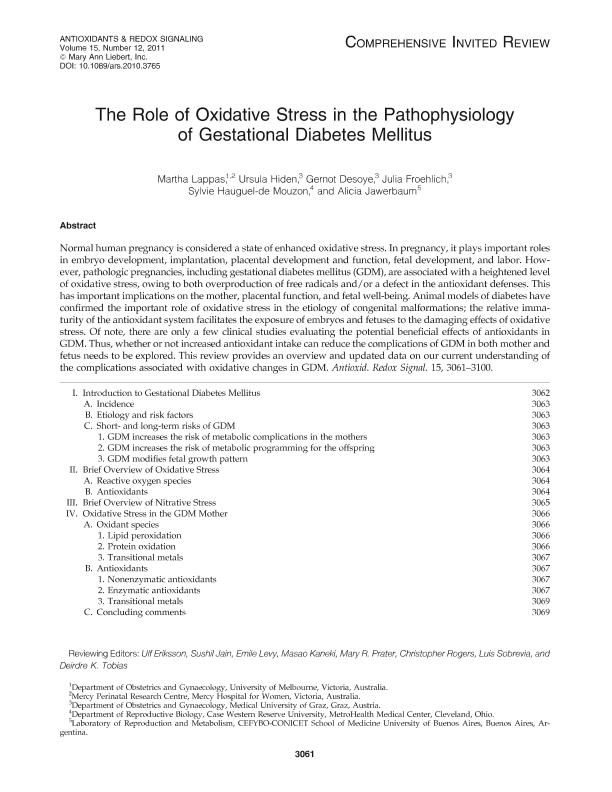Mostrar el registro sencillo del ítem
dc.contributor.author
Lappas, Martha

dc.contributor.author
Hiden, Ursula

dc.contributor.author
Desoye, Gernot

dc.contributor.author
Froehlich, Julia

dc.contributor.author
Hauguel de Mouzon, Sylvie

dc.contributor.author
Jawerbaum, Alicia Sandra

dc.date.available
2017-06-02T21:16:20Z
dc.date.issued
2011-10
dc.identifier.citation
Lappas, Martha; Hiden, Ursula; Desoye, Gernot; Froehlich, Julia; Hauguel de Mouzon, Sylvie; et al.; The role of oxidative stress in the pathophysiology of gestational diabetes mellitus; Mary Ann Liebert Inc; Antioxidants & Redox Signaling; 15; 12; 10-2011; 3061-3100
dc.identifier.issn
1523-0864
dc.identifier.uri
http://hdl.handle.net/11336/17444
dc.description.abstract
Normal human pregnancy is considered a state of enhanced oxidative stress. In pregnancy, it plays important roles in embryo development, implantation, placental development and function, fetal development, and labor. However, pathologic pregnancies, including gestational diabetes mellitus (GDM), are associated with a heightened level of oxidative stress, owing to both overproduction of free radicals and/or a defect in the antioxidant defenses. This has important implications on the mother, placental function, and fetal well-being. Animal models of diabetes have confirmed the important role of oxidative stress in the etiology of congenital malformations; the relative immaturity of the antioxidant system facilitates the exposure of embryos and fetuses to the damaging effects of oxidative stress. Of note, there are only a few clinical studies evaluating the potential beneficial effects of antioxidants in GDM. Thus, whether or not increased antioxidant intake can reduce the complications of GDM in both mother and fetus needs to be explored. This review provides an overview and updated data on our current understanding of the complications associated with oxidative changes in GDM.
dc.format
application/pdf
dc.language.iso
eng
dc.publisher
Mary Ann Liebert Inc

dc.rights
info:eu-repo/semantics/openAccess
dc.rights.uri
https://creativecommons.org/licenses/by-nc-sa/2.5/ar/
dc.subject
Diabetes
dc.subject
Pregnancy
dc.subject
Oxidative Stress
dc.subject
Placenta
dc.subject.classification
Bioquímica y Biología Molecular

dc.subject.classification
Medicina Básica

dc.subject.classification
CIENCIAS MÉDICAS Y DE LA SALUD

dc.title
The role of oxidative stress in the pathophysiology of gestational diabetes mellitus
dc.type
info:eu-repo/semantics/article
dc.type
info:ar-repo/semantics/artículo
dc.type
info:eu-repo/semantics/publishedVersion
dc.date.updated
2017-05-31T20:04:14Z
dc.journal.volume
15
dc.journal.number
12
dc.journal.pagination
3061-3100
dc.journal.pais
Estados Unidos

dc.journal.ciudad
Nueva York
dc.description.fil
Fil: Lappas, Martha. The University of Melbourne; Australia
dc.description.fil
Fil: Hiden, Ursula. University of Graz; Austria
dc.description.fil
Fil: Desoye, Gernot. University of Graz; Austria
dc.description.fil
Fil: Froehlich, Julia. University of Graz; Austria
dc.description.fil
Fil: Hauguel de Mouzon, Sylvie. Case Western Reserve University; Estados Unidos
dc.description.fil
Fil: Jawerbaum, Alicia Sandra. Consejo Nacional de Investigaciones Científicas y Técnicas. Oficina de Coordinación Administrativa Houssay. Centro de Estudios Farmacológicos y Botánicos. Universidad de Buenos Aires. Facultad de Medicina. Centro de Estudios Farmacológicos y Botánicos; Argentina
dc.journal.title
Antioxidants & Redox Signaling

dc.relation.alternativeid
info:eu-repo/semantics/altIdentifier/url/http://online.liebertpub.com/doi/abs/10.1089/ars.2010.3765
dc.relation.alternativeid
info:eu-repo/semantics/altIdentifier/doi/http://dx.doi.org/10.1089/ars.2010.3765
Archivos asociados
